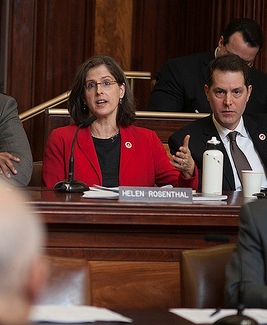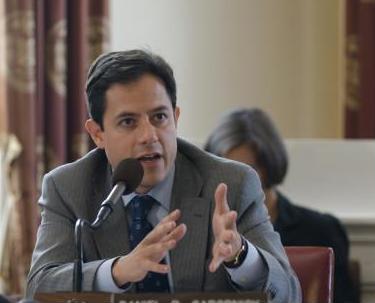Park Equity Begins with a Better Public Budget

(NY4P.org)
An early springtime sun was shining down on Seward Park as Mayor de Blasio introduced Mitchell Silver as New York City's next parks commissioner last month on the Lower East Side. It was an inspiring day for park advocates across the city, as both the mayor and incoming commissioner offered thoughtful, even-handed commentary centered on a clear goal: a fairer park system for all New Yorkers.
Now, with budget season upon us, we're pleased to see that the mayor's preliminary budget for parks not only baselines many of the important restorations made over the past few years, such as street-tree care and stump removal, but funds items up front that are usually subject to the annual budget dance, such as Playground Associates and seasonal workers to staff pools, among other facilities.
This good news gives the parks community the opportunity to turn its attention to the larger issue of addressing inequities across the park system – including at a city council hearing next Wednesday, April 23rd. The solution is complex and nuanced. While many of the large park conservancies are ready to work with the commissioner on bringing more private resources – financial and otherwise – to parks in need, it's clear, as council parks and recreation committee chair Mark Levine noted recently in the Huffington Post, that addressing inequities must begin with the public budget. There are several specific budget and policy reforms that the administration and its Department of Parks and Recreation (DPR) can undertake in the name of equity and fairness.
Expense budget
On the expense side, fostering greater equity will require addressing the top concern of many local park advocates across the city: there simply isn't enough full-time staff assigned to the parks that need them most. Rather, 75 percent of DPR's maintenance staff is made up of Job Training Participants (JTP) who work at DPR up to six months but are almost never given an opportunity for permanent employment once their training is complete. "Almost as soon as they're really up to speed on the park, they cycle out," a local advocate told us recently. Her comment rings true across the city.
At the same time, many advocates tell us that having full-time staff – a familiar face in the park – goes a long way toward improving the overall park experience for users. These issues offer Mayor de Blasio and Commissioner Silver an opportunity to both address park equity issues and create good entry-level jobs.
What would those jobs be, where would they make the most immediate impact, and how much money is needed to create them? A good place to start would be to create a neighborhood parks fund of $10 million, which would allow Commissioner Silver to work with the Council on a plan that really starts to address needs in underserved parks. Here are a few ways such a fund could be spent in high-need areas:
- $4 million for 100 full-time workers to staff playgrounds with comfort stations.
- $3 million for 50 skilled full-time gardeners to help maintain midsized neighborhood parks.
Our organization learned first-hand how important these positions are when we helped lead the Neighborhood Parks Initiative almost 10 years ago.
Not only would these new positions start making a difference for parks most in need right away, but they'd offer an opportunity for DPR's part-time workers to gain full-time employment through a new, robust training program to help transition JTP staff into full-time maintenance workers and gardeners.
- $3 million for park-tree pruning and stump removal. Though DPR has shortened its street-tree pruning cycle thanks to recent budget restorations, it still prunes very few park trees.
- $2 million would allow DPR to prune at least about 25,000 trees in parks: a good start toward a pruning cycle.
- An additional million dollars would allow DPR to remove approximately 4,000 more stumps.
Capital budget
There is also an opportunity to address park inequities through the capital budget. In recent years, the Department of Parks and Recreation has not had a meaningful discretionary budget to really enable it to plan for and fund capital projects over time across parks citywide. Rather, DPR has been reliant for funding for the majority of its projects on piecemeal discretionary allocations from city council members and borough presidents. Cobbling together allocations over multiple fiscal years from different elected officials is inefficient, leads to inequitable results, and often means the nuts-and-bolts needs of parks across the city fall through the cracks.
We are pleased to see that our call for increased discretionary capital funding, as highlighted in our Parks Platform 2013, seems to have been heard: the initial fiscal year 2015 budget contains a significant amount of capital funding for parks, and it appears to be at the discretion of Commissioner Silver. We call on the Council and administration to ensure that this funding remains in the final budget. At the same time, our recent research on improving the timeliness of capital construction shows that funding should be added to the budget for additional full-time positions in the capital division.
The introduction of Mitchell Silver, an urban planner, ushered in a new era not only for New York City's parks, but for its neighborhoods. After all, parks lie at the heart of city neighborhood life, in every corner of each borough – infrastructure as essential as housing, sewer lines and roads. The community building impact these spaces have extends far beyond their boundaries. Park issues are neighborhood issues.
As Commissioner Silver takes office, we're hopeful the administration and Council will supply him with the budgetary tools needed to really address inequity – and, in turn, lift the park system as a whole.
***
Tupper Thomas is the Executive Director of New Yorkers for Parks, an independent research and advocacy organization.
Preliminary Budget Questions Remain

Council Member Helen Rosenthal (William Alitriste)
I have always been fascinated by quantifying public policy and the very practical details of implementation. Diving into the details, one can learn if public dollars are being spent wisely and efficiently or not.
March madness for the Council is the near daily set of hearings with each city agency to review their budgets. These hearings can last hours as council members try to decipher what agencies are spending their money on and whether or not the agency needs more or less funding to provide adequate city services.
I view the City's $73 billion expense budget as a concrete reflection of the City's public policy. The broad brush "progressive" goals are to address income inequality; every tax dollar spent should be geared toward stabilizing the middle class and helping those who depend on government services. Toward this end, lots of questions were raised during the March Preliminary Budget Hearings, and we're still waiting for the answers.
For example: How much is the City investing in Minority & Women-Owned Business Enterprise (M/WBE) training programs? What industries does Economic Development Corporation (EDC) plan to invest in to support middle-wage workers?
I also have serious questions about the contracts issued through the Department of Education (DOE) Central Administration. Are contracts that, in sum, cost over $115 million good investments? For all technology investments, are we paying outside contractors to do day-to-day work, or are they setting up systems then training city workers to implement programs? How can DOE do a better job billing Medicaid for special education services? Right now, 75% of our DOE special education expenditures could be paid for by the state and federal governments, and we lose millions every year by under-billing.
And, why is the Department of Homeless Services (DHS) spending $3,600 per month for each adult couple for a single room and shared bathroom with minimal social services? How can we provide the service without paying the Single Room Occupancy (SRO) landlords so much money? Can the Department of Housing Preservation and Development (HPD) find funds to reverse their downsizing policy, which has been moving elderly seniors out of their homes (and traumatizing them in the process)? Why is the New York City Housing Authority (NYCHA) spending millions of dollars on temporary home-heating boilers that don't work below 40 degrees?
While the City Council develops its response to the mayor's budget, my hope is that each of the agencies will take our questions into consideration as they prepare for the Executive Budget (due in May). As I made clear to the Director for the Office of Management and Budget (OMB), I expect the Mayor's May budget to reflect the Administration's public policy to address income inequality.
Council Member Helen Rosenthal represents District 6 (Upper West Side) and is Chair of the Contracts Committee. Rosenthal is a member of the Council's Budget Negotiation Team and was recently elected Vice Chair for Budget in the Progressive Caucus.
The opinions written here are her own and are a reflection of her seven years work experience in the NYC Office of Management and Budget.
What’s Next for East Midtown
Council Member Dan Garodnick (D-Manhattan)
There was a lot of talk last year about the urgent need to rejuvenate East Midtown.
Mayor Bloomberg offered a serious, but incomplete, rezoning proposal. Too many questions remained about the improvements to Grand Central's infrastructure and the pricing of air rights to advance new development. The ball is now in Mayor de Blasio's court, and we hope he will run with it.
The need for action results from antiquated zoning rules which trap buildings in their current condition. Today, someone who tears down their building can only build back to the same size if they retain 25 percent of their structure. The economics of those regulations leaves few developers willing to terminate leases, vacate buildings, demolish, and rebuild. One early concept simply allowed those buildings to rebuild up to their current densities, essentially "grandfathering" them in.
The rezoning proposal that emerged, however, added even more density by allowing developers to purchase air rights at $250/foot, to be used to finance local infrastructure. While it allowed for the purchase of air rights, it unwisely set the price of those air rights the same across an 80 block territory. It committed considerable sums for infrastructure, but without certainty that they would be used for the most needed improvements. At our insistence, a public realm plan was proposed, but it was unclear if many of the recommendations could actually be implemented. In short, the goals were laudable, but for a plan that would take effect over decades, we needed more time to get it right.
Now we can. We have an opportunity to create the right environment to allow East Midtown to keep its competitive edge. As we devise a new plan, we should consider why companies will want to locate in East Midtown over the next 50 years, and how we want this area to function in the context of New York City's other central business districts.
The proposal should be for a vibrant 21st Century business district, and not an isolated set of new skyscrapers, disconnected to the world around them. That means we need to consider the appropriate density and urban design for the entire district, and to provide that future development improve pedestrian and transit circulation, open space, and access to daylight. We also need to be mindful of the historic fabric of midtown and consider which important buildings should be preserved.
We should revisit the mechanism for pricing air rights -- and consider whether there are other models, such as a tax assessment or tax increment finance district to fund infrastructure, or a broader air rights transfer option, which may be a better fit.
As we proceed with this discussion, let's not forget that the challenges with this area's infrastructure need to be addressed with or without any rezoning proposal. The Lexington Avenue subway platforms at Grand Central are so overburdened as to make them dangerous; East Side Access will be open at some point, and will require better access points to the street; and our sidewalks and public spaces should allow for better and safer pedestrian flow. Simply put, we need a vision for our sidewalks, parks, plazas, and elsewhere - to complement any new buildings that are built.
Many of us have been grappling with these questions for the better part of two years. The Mayor has stated that he will submit a new rezoning proposal this year, and I look forward to working with him toward the more complete plan that East Midtown deserves.
Dan Garodnick is a member of the New York City Council representing the fourth district, in Manhattan, which includes East Midtown. Garodnick has served on the Council since 2006.





